Water Quality Modelling for Nitrate Nitrogen Control Using HEC-RAS: Case Study of Nakdong River in South Korea
Abstract
:1. Introduction
2. Materials and Methods
2.1. Study Area
2.2. Model Description
2.3. Data for HEC-RAS Model
2.3.1. Data Availability
2.3.2. Data Preparation
2.4. Experimental Setup
3. Results
3.1. Calibration and Validation
3.1.1. Unsteady Flow
3.1.2. NO3-N Dynamics
3.2. Scenario-Based NO3-N Dynamics
3.2.1. Variation in Water Quantity
3.2.2. Variation in Water Quality
3.3. Guidelines for Design of Strategies to Control NO3-N Downstream
4. Discussion
5. Conclusions
Author Contributions
Funding
Institutional Review Board Statement
Informed Consent Statement
Data Availability Statement
Acknowledgments
Conflicts of Interest
References
- UNESCO; UN-Water. United Nations World Water Development Report 2020: Water and Climate Change; UNESCO: Paris, France, 2020; Available online: https://www.unwater.org/publications/un-world-water-development-report-2020 (accessed on 28 September 2022).
- WHO. Guidelines for Drinking-Water Quality: Fourth Edition Incorporating the First and Second Addenda, 4th ed.; World Health Organization: Geneva, Switzerland, 2022; Available online: https://www.who.int/publications/i/item/9789240045064 (accessed on 22 September 2022).
- Celikkol, S.; Fortin, N.; Tromas, N.; Andriananjamanantsoa, H.; Greer, C.W. Bioavailable Nutrients (N and P) and Precipitation Patterns Drive Cyanobacterial Blooms in Missisquoi Bay, Lake Champlain. Microorganisms 2021, 9, 2097. [Google Scholar] [CrossRef] [PubMed]
- Ward, M.H.; deKok, T.M.; Levallois, P.; Brender, J.; Gulis, G.; Nolan, B.T.; VanDerslice, J. Workgroup Report: Drinking-Water Nitrate and Health—Recent Findings and Research Needs. Environ. Health Perspect. 2005, 113, 1607–1614. [Google Scholar] [CrossRef] [PubMed] [Green Version]
- Danaraj, J.; Ushani, U.; Packiavathy, S.V.; Dharmadhas, J.S.; Karuppiah, T.; Anandha Kumar, S.; Aooj, E.S. Climate Change Impacts of Nitrate Contamination on Human Health. In Climate Change Impact on Groundwater Resources: Human Health Risk Assessment in Arid and Semi-Arid Regions; Panneerselvam, B., Pande, C.B., Muniraj, K., Balasubramanian, A., Ravichandran, N., Eds.; Springer International Publishing: Cham, Switzerland, 2022; pp. 257–278. [Google Scholar]
- Ward, M.H.; Jones, R.R.; Brender, J.D.; de Kok, T.M.; Weyer, P.J.; Nolan, B.T.; Villanueva, C.M.; van Breda, S.G. Drinking Water Nitrate and Human Health: An Updated Review. Int. J. Environ. Res. Public Health 2018, 15, 1557. [Google Scholar] [CrossRef] [PubMed] [Green Version]
- Lee, C.-M.; Hamm, S.-Y.; Cheong, J.-Y.; Kim, K.; Yoon, H.; Kim, M.; Kim, J. Contribution of Nitrate-Nitrogen Concentration in Groundwater to Stream Water in an Agricultural Head Watershed. Environ. Res. 2020, 184, 109313. [Google Scholar] [CrossRef] [PubMed]
- Nakagawa, K.; Amano, H.; Asakura, H.; Berndtsson, R. Spatial Trends of Nitrate Pollution and Groundwater Chemistry in Shimabara, Nagasaki, Japan. Environ. Earth Sci. 2016, 75, 234. [Google Scholar] [CrossRef] [Green Version]
- Musacchio, A.; Re, V.; Mas-Pla, J.; Sacchi, E. EU Nitrates Directive, from Theory to Practice: Environmental Effectiveness and Influence of Regional Governance on Its Performance. Ambio 2020, 49, 504–516. [Google Scholar] [CrossRef] [PubMed] [Green Version]
- Elzain, H.E.; Chung, S.Y.; Senapathi, V.; Sekar, S.; Lee, S.Y.; Priyadarsi, R.D.; Hassan, A.; Sabarathinam, C. Comparative Study of Machine Learning Models for Evaluating Groundwater Vulnerability to Nitrate Contamination. Ecotoxicol. Environ. Saf. 2022, 229, 113061. [Google Scholar] [CrossRef]
- Yang, L.; Yu, X. A Review of Development and Application on River Comprehensive Water Quality Model QUAL2K. In IOP Conference Series: Earth and Environmental Science; IOP Publishing: Bristol, UK, 2018. [Google Scholar]
- Kim, J.; Jonoski, A.; Solomatine, D.P. A Classification-Based Machine Learning Approach to the Prediction of Cyanobacterial Blooms in Chilgok Weir, South Korea. Water 2022, 14, 542. [Google Scholar] [CrossRef]
- Park, Y.; Lee, H.K.; Shin, J.-K.; Chon, K.; Kim, S.; Cho, K.H.; Kim, J.H.; Baek, S.-S. A Machine Learning Approach for Early Warning of Cyanobacterial Bloom Outbreaks in a Freshwater Reservoir. J. Environ. Manag. 2021, 288, 112415. [Google Scholar] [CrossRef]
- Zhao, W.X.; Li, Y.Y.; Jiao, Y.J.; Zhou, B.; Vogt, R.D.; Liu, H.L.; Ji, M.; Ma, Z.; Li, A.D.; Zhou, B.H.; et al. Spatial and Temporal Variations in Environmental Variables in Relation to Phytoplankton Community Structure in a Eutrophic River-Type Reservoir. Water 2017, 9, 754. [Google Scholar] [CrossRef]
- Paerl, H.W.; Otten, T.G. Harmful Cyanobacterial Blooms: Causes, Consequences, and Controls. Microb. Ecol. 2013, 65, 995–1010. [Google Scholar] [CrossRef] [PubMed]
- Falconer, I.R.; Humpage, A.R. Health Risk Assessment of Cyanobacterial (Blue-Green Algal) Toxins in Drinking Water. Int. J. Environ. Res. Public Health 2005, 2, 43–50. [Google Scholar] [CrossRef] [PubMed] [Green Version]
- Ho, L.; Goethals, P. Research Hotspots and Current Challenges of Lakes and Reservoirs: A Bibliometric Analysis. Scientometrics 2020, 124, 603–631. [Google Scholar] [CrossRef] [Green Version]
- Park, H.-K.; Lee, H.-J.; Heo, J.; Yun, J.-H.; Kim, Y.-J.; Kim, H.-M.; Hong, D.-G.; Lee, I.-J. Deciphering the Key Factors Determining Spatio-Temporal Heterogeneity of Cyanobacterial Bloom Dynamics in the Nakdong River with Consecutive Large Weirs. Sci. Total Environ. 2021, 755, 143079. [Google Scholar] [CrossRef]
- Park, Y.; Pyo, J.; Kwon, Y.S.; Cha, Y.; Lee, H.; Kang, T.; Cho, K.H. Evaluating Physico-Chemical Influences on Cyanobacterial Blooms Using Hyperspectral Images in Inland Water, Korea. Water Res. 2017, 126, 319–328. [Google Scholar] [CrossRef] [PubMed]
- Song, H.; Lynch, M.J. Restoration of Nature or Special Interests? A Political Economy Analysis of the Four Major Rivers Restoration Project in South Korea. Crit. Criminol. 2018, 26, 251–270. [Google Scholar] [CrossRef]
- Romo, S.; Soria, J.; Fernandez, F.; Ouahid, Y.; Baron-Sola, A. Water Residence Time and the Dynamics of Toxic Cyanobacteria. Freshw. Biol. 2013, 58, 513–522. [Google Scholar] [CrossRef]
- Aguilar, J.; Van Andel, S.-J.; Werner, M.; Solomatine, D.P. Hydrodynamic and Water Quality Surrogate Modeling for Reservoir Operation. In Proceedings of the 11th International Conference on Hydroinformatics, New York, NY, USA, 17–21 August 2014. [Google Scholar]
- Engel, B.; Storm, D.; White, M.; Arnold, J.; Arabi, M. A Hydrologic/Water Quality Model Application Protocol. J. Am. Water Resour. Assoc. 2007, 43, 1223–1236. [Google Scholar] [CrossRef]
- Ejigu, M.T. Overview of Water Quality Modeling. Cogent Eng. 2021, 8, 1891711. [Google Scholar] [CrossRef]
- Rousso, B.Z.; Bertone, E.; Stewart, R.; Hamilton, D.P. A Systematic Literature Review of Forecasting and Predictive Models for Cyanobacteria Blooms in Freshwater Lakes. Water Res. 2020, 182, 115959. [Google Scholar] [CrossRef]
- Srivastava, P.; McVair, J.N.; Johnson, T.E. Comparison of Process-Based and Artificial Neural Network Approaches for Streamflow Modeling in an Agricultural Watershed. J. Am. Water Resour. Assoc. 2006, 42, 545–563. [Google Scholar] [CrossRef]
- Razavi, S.; Tolson, B.A.; Burn, D.H. Review of Surrogate Modeling in Water Resources. Water Resour. Res. 2012, 48, W07401. [Google Scholar] [CrossRef]
- Costa, C.M.d.B.; Leite, I.R.; Almeida, A.K.; de Almeida, I.K. Choosing an Appropriate Water Quality Model-a Review. Environ. Monit. Assess. 2021, 193, 38. [Google Scholar] [CrossRef] [PubMed]
- Alam, M.J.; Dutta, D. Modelling of Nutrient Pollution Dynamics in River Basins: A Review with a Perspective of a Distributed Modelling Approach. Geosciences 2021, 11, 369. [Google Scholar] [CrossRef]
- Gunawardena, M.P.; Najim, M.M.M. Adapting Sri Lanka to Climate Change: Approaches to Water Modelling in the Upper Mahaweli Catchment Area. In Climate Change Research at Universities: Addressing the Mitigation and Adaptation Challenges; Leal Filho, W., Ed.; Springer International Publishing: Cham, Switzerland, 2017; pp. 95–115. [Google Scholar]
- Abed, B.S.; Daham, M.H.; Al-Thamiry, H.A. Assessment and Modelling of Water Quality along Al-Gharraf River (Iraq). J. Green Eng. 2020, 10, 13565–13579. [Google Scholar]
- Brunner, G.W. HEC-RAS River Analysis System User’s Manual Version 5.0; U.S. Army Corps of Engineers, Institute for Water Resources, Hydrologic Engineering Center: Davis, CA, USA, 2016; Available online: https://www.hec.usace.army.mil/software/hec-ras/documentation/HEC-RAS%205.0%20Users%20Manual.pdf (accessed on 20 January 2022).
- Teran-Velasquez, G.; Helm, B.; Krebs, P. Longitudinal River Monitoring and Modelling Substantiate the Impact of Weirs on Nitrogen Dynamics. Water 2022, 14, 189. [Google Scholar] [CrossRef]
- Taralgatti, P.D.; Pawar, R.S.; Pawar, G.S.; Nomaan, M.H.; Limkar, C.R. Water Quality Modeling of Bhima River by Using HEC-RAS Software. Int. J. Eng. Adv. Technol. 2020, 9, 2886–2889. [Google Scholar] [CrossRef]
- Abed, B.S.; Daham, M.H.; Ismail, A.H. Water Quality Modelling and Management of Diyala River and Its Impact on Tigris River. J. Eng. Sci. Technol. 2021, 16, 122–135. [Google Scholar]
- Ghafoor, J.; Forio, M.A.E.; Goethals, P.L.M. Spatially Explicit River Basin Models for Cost-Benefit Analyses to Optimize Land Use. Sustainability 2022, 14, 8953. [Google Scholar] [CrossRef]
- Lee, H.-J.; Park, H.-K.; Cheon, S.-U. Effects of Weir Construction on Phytoplankton Assemblages and Water Quality in a Large River System. Int. J. Environ. Res. Public Health 2018, 15, 2348. [Google Scholar] [CrossRef] [Green Version]
- Kim, D.-H.; Lee, S.-K.; Chun, B.-Y.; Lee, D.-H.; Hong, S.-C.; Jang, B.-K. Illness Associated with Contamination of Drinking Water Supplies with Phenol. J. Korean Med. Sci. 1994, 9, 218–223. [Google Scholar] [CrossRef] [PubMed] [Green Version]
- Jo, C.D.; Lee, C.G.; Kwon, H.G. Effects of Multifunctional Weir Construction on Key Water Quality Indicators: A Case Study in Nakdong River, Korea. Int. J. Environ. Sci. Technol. 2022, 19, 11843–11856. [Google Scholar] [CrossRef]
- Park, J.; Wang, D.; Lee, W.H. Evaluation of Weir Construction on Water Quality Related to Algal Blooms in the Nakdong River. Environ. Earth Sci. 2018, 77, 408. [Google Scholar] [CrossRef]
- Jeong, J.-W.; Kim, Y.-O.; Seo, S.B. Evaluating Joint Operation Rules for Connecting Tunnels between Two Multipurpose Dams. Hydrol. Res. 2020, 51, 392–405. [Google Scholar] [CrossRef]
- Park, J.C.; Um, M.-J.; Song, Y.-I.; Hwang, H.-D.; Kim, M.M.; Park, D. Modeling of Turbidity Variation in Two Reservoirs Connected by a Water Transfer Tunnel in South Korea. Sustainability 2017, 9, 993. [Google Scholar] [CrossRef] [Green Version]
- Lee, S.; Kim, J.; Noh, J.; Ko, I.H. Assessment of Selective Withdrawal Facility in the Imha Reservoir Using CE-QUAL-W2 Model. J. Korean Soc. Water Environ. 2007, 23, 228–235. [Google Scholar]
- Park, H.-S.; Chung, S.-W. Water Transportation and Stratification Modification in the Andong-Imha Linked Reservoirs System. J. Korean Soc. Water Environ. 2014, 30, 31–43. [Google Scholar] [CrossRef] [Green Version]
- Lee, J.; Bae, S.; Lee, D.-R.; Seo, D. Transportation Modeling of Conservative Pollutant in a River with Weirs-The Nakdong River Case. J. Korean Soc. Environ. Eng. 2014, 36, 821–827. [Google Scholar] [CrossRef] [Green Version]
- Bae, S.; Seo, D. Changes in Algal Bloom Dynamics in a Regulated Large River in Response to Eutrophic Status. Ecol. Model. 2021, 454, 109590. [Google Scholar] [CrossRef]
- Kim, D.; Shin, C. Algal Boom Characteristics of Yeongsan River Based on Weir and Estuary Dam Operating Conditions Using EFDC-NIER Model. Water 2021, 13, 2295. [Google Scholar] [CrossRef]
- Choi, H.-G.; Han, K.-Y. Development and Applicability Assessment of 1-D Water Quality Model in Nakdong River. KSCE J. Civ. Eng. 2014, 18, 2234–2243. [Google Scholar] [CrossRef]
- Leonard, B.P. A Stable and Accurate Convective Modelling Procedure Based on Quadratic Upstream Interpolation. Comput. Methods Appl. Mech. Eng. 1979, 19, 59–98. [Google Scholar] [CrossRef]
- Leonard, B.P. The ULTIMATE Conservative Difference Scheme Applied to Unsteady One-Dimensional Advection. Comput. Methods Appl. Mech. Eng. 1991, 88, 17–74. [Google Scholar] [CrossRef]
- Korea Legislation Research Institute. The Statutes of the Republic of Korea Home Page: River Act. Available online: https://elaw.klri.re.kr/eng_service/lawView.do?hseq=57588&lang=ENG (accessed on 28 September 2022).
- Kim, J.; Seo, D.; Jang, M.; Kim, J. Augmentation of Limited Input Data Using an Artificial Neural Network Method to Improve the Accuracy of Water Quality Modeling in a Large Lake. J. Hydrol. 2021, 602, 126817. [Google Scholar] [CrossRef]
- Korea Legislation Research Institute. The Statutes of the Republic of Korea Home Page: Act on the Investigation, Planning, and Management of Water Resources. Available online: https://elaw.klri.re.kr/eng_service/lawView.do?hseq=55436&lang=ENG (accessed on 28 September 2022).
- Korea Legislation Research Institute. The Statutes of the Republic of Korea Home Page: Water Environment Conservation Act. Available online: https://elaw.klri.re.kr/eng_service/lawView.do?hseq=54838&lang=ENG (accessed on 28 September 2022).
- Korea Legislation Research Institute. The Statutes of the Republic of Korea Home Page: Weather Act. Available online: https://elaw.klri.re.kr/eng_service/lawView.do?hseq=54691&lang=ENG (accessed on 28 September 2022).
- Cullinan, V.I.; May, C.W.; Brandenberger, J.M.; Judd, C.; Johnston, R.K. Development of an Empirical Water Quality Model for Stormwater Based on Watershed Land Use in Puget Sound; Space and Naval Warfare Systems Center, Marine Environmental Support Office: Bremerton, WA, USA, 2007; Available online: https://apps.dtic.mil/sti/citations/ADA519147 (accessed on 23 September 2022).
- James, R.T. Recalibration of the Lake Okeechobee Water Quality Model (LOWQM) to Extreme Hydro-Meteorological Events. Ecol. Model. 2016, 325, 71–83. [Google Scholar] [CrossRef]
- McIntyre, N.R.; Wheater, H.S. A Tool for Risk-Based Management of Surface Water Quality. Environ. Model. Softw. 2004, 19, 1131–1140. [Google Scholar] [CrossRef]
- Kim, J.; Lee, T.; Seo, D. Algal Bloom Prediction of the Lower Han River, Korea Using the EFDC Hydrodynamic and Water Quality Model. Ecol. Model. 2017, 366, 27–36. [Google Scholar] [CrossRef]
- Yi, H.-S.; Park, S.; An, K.-G.; Kwak, K.-C. Algal Bloom Prediction Using Extreme Learning Machine Models at Artificial Weirs in the Nakdong River, Korea. Int. J. Environ. Res. Public Health 2018, 15, 2078. [Google Scholar] [CrossRef] [Green Version]
- Zhang, Z.; Johnson, B.E. Aquatic Nutrient Simulation Modules (NSMs) Developed for Hydrologic and Hydraulic Models; U.S. Army Engineer Research and Development Center, Environmental Laboratory: Vicksburg, MS, USA, 2016; Available online: https://erdc-library.erdc.dren.mil/jspui/bitstream/11681/10112/1/ERDC-EL-TR-16-1.pdf (accessed on 20 January 2022).
- Meybeck, M. Carbon, Nitrogen, and Phosphorus Transport by World Rivers. Am. J. Sci. 1982, 282, 401–450. [Google Scholar] [CrossRef]
- Park, J.; Sohn, S.; Kim, Y. Distribution Characteristics of Total Nitrogen Components in Streams by Watershed Characteristics. J. Korean Soc. Water Environ. 2014, 30, 503–511. [Google Scholar] [CrossRef] [Green Version]
- Bhuyan, K.J.; Saharia, P.K.; Sarma, D.; Bhagawati, K.; Baishya, S.; Hazarika, S.R. Effect of Periphyton (Streblus Asper Lour.) Assemblage on Water quality Parameters and Growth Perfomance of Jayanti Rohu and Amur Common Carp in the Aquaculture System. J. Krishi Vigyan 2020, 9, 74–80. [Google Scholar] [CrossRef]
- Mihale, M.J. Nitrogen and Phosphorus Dynamics in the Waters of the Great Ruaha River, Tanzania. J. Water Resour. Ocean Sci. 2015, 4, 59–71. [Google Scholar] [CrossRef] [Green Version]
- Rus, D.L.; Patton, C.J.; Mueller, D.K.; Crawford, C.G. Assessing Total Nitrogen in Surface-Water Samples: Precision and Bias of Analytical and Computational Methods; U.S. Department of the Interior, U.S. Geological Survey: Reston, VA, USA, 2012. Available online: https://pubs.usgs.gov/sir/2012/5281 (accessed on 15 September 2022).
- Hem, J.D. Study and Interpretation of the Chemical Characteristics of Natural Water; U.S. Department of the Interior, U.S. Geological Survey: Alexandria, VA, USA, 1985. [Google Scholar]
- Daggupati, P.; Pai, N.; Ale, S.; Douglas-Mankin, K.R.; Zeckoski, R.W.; Jeong, J.; Parajuli, P.B.; Saraswat, D.; Youssef, M.A. A Recommended Calibration and Validation Strategy for Hydrologic and Water Quality Models. T. Asabe 2015, 58, 1705–1719. [Google Scholar] [CrossRef]
- Moriasi, D.N.; Gitau, M.W.; Pai, N.; Daggupati, P. Hydrologic and Water Quality Models: Performance Measures and Evaluation Criteria. T. Asabe 2015, 58, 1763–1785. [Google Scholar] [CrossRef] [Green Version]
- Reynolds, C.S. The Ecology of Phytoplankton; Cambridge University Press: New York, NY, USA, 2006. [Google Scholar]
- Ferber, L.R.; Levine, S.N.; Lini, A.; Livingston, G.P. Do Cyanobacteria Dominate in Eutrophic Lakes Because They Fix Atmospheric Nitrogen? Freshwater Biol. 2004, 49, 690–708. [Google Scholar] [CrossRef]
- Weyhenmeyer, G.A.; Jeppesen, E.; Adrian, R.; Arvola, L.; Blenckner, T.; Jankowski, T.; Jennings, E.; Nõges, P.; Nõges, T.; Straile, D. Nitrate-Depleted Conditions on the Increase in Shallow Northern European Lakes. Limnol. Oceanogr. 2007, 52, 1346–1353. [Google Scholar] [CrossRef] [Green Version]
- Talib, A.; Recknagel, F.; Cao, H.; van der Molen, D.; Abu Hasan, Y. Use of Hybrid EA Models for the Prediction of Chlorophyll-a and Phytoplankton Functional Groups Abundance in Two Shallow Lakes. Malays. J. Math. Sci. 2008, 2, 11–28. [Google Scholar]
- Ustaoglu, F.; Tas, B.; Tepe, Y.; Topaldemir, H. Comprehensive Assessment of Water Quality and Associated Health Risk by Using Physicochemical Quality Indices and Multivariate Analysis in Terme River, Turkey. Environ. Sci. Pollut. Res. 2021, 28, 62736–62754. [Google Scholar] [CrossRef]
- Forio, M.A.E.; Goethals, P.L.M. An Integrated Approach of Multi-Community Monitoring and Assessment of Aquatic Ecosystems to Support Sustainable Development. Sustainability 2020, 12, 5603. [Google Scholar] [CrossRef]
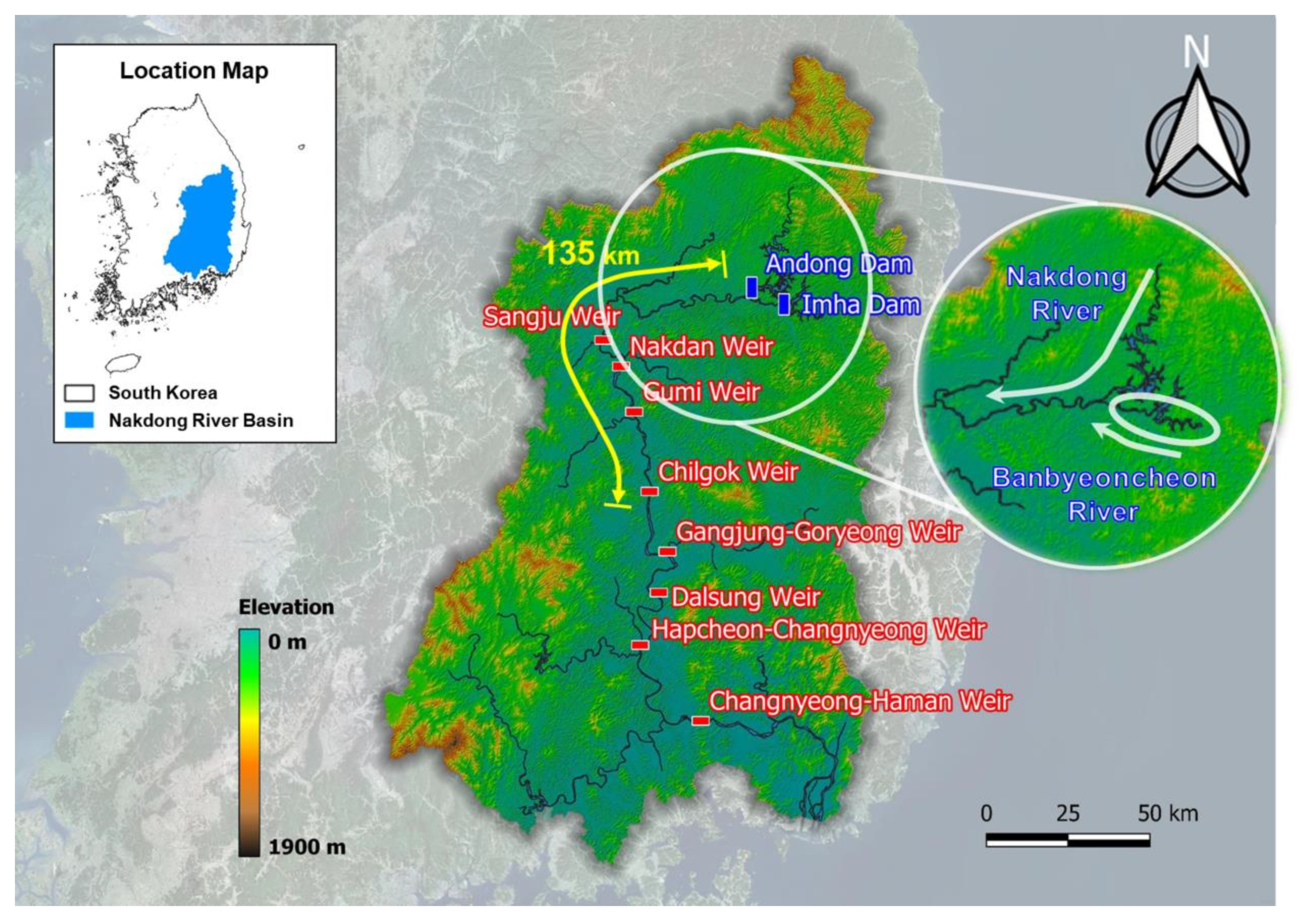


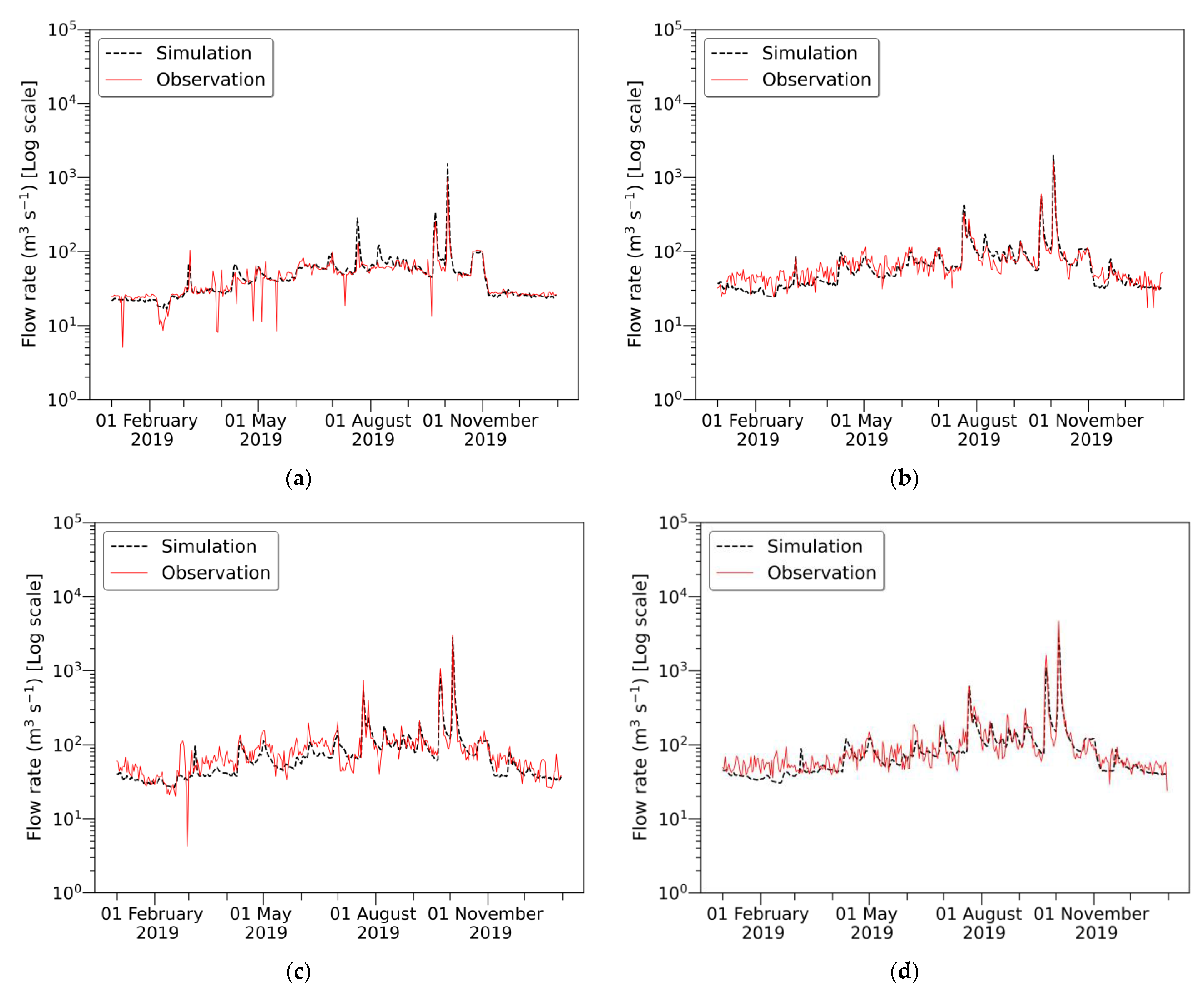
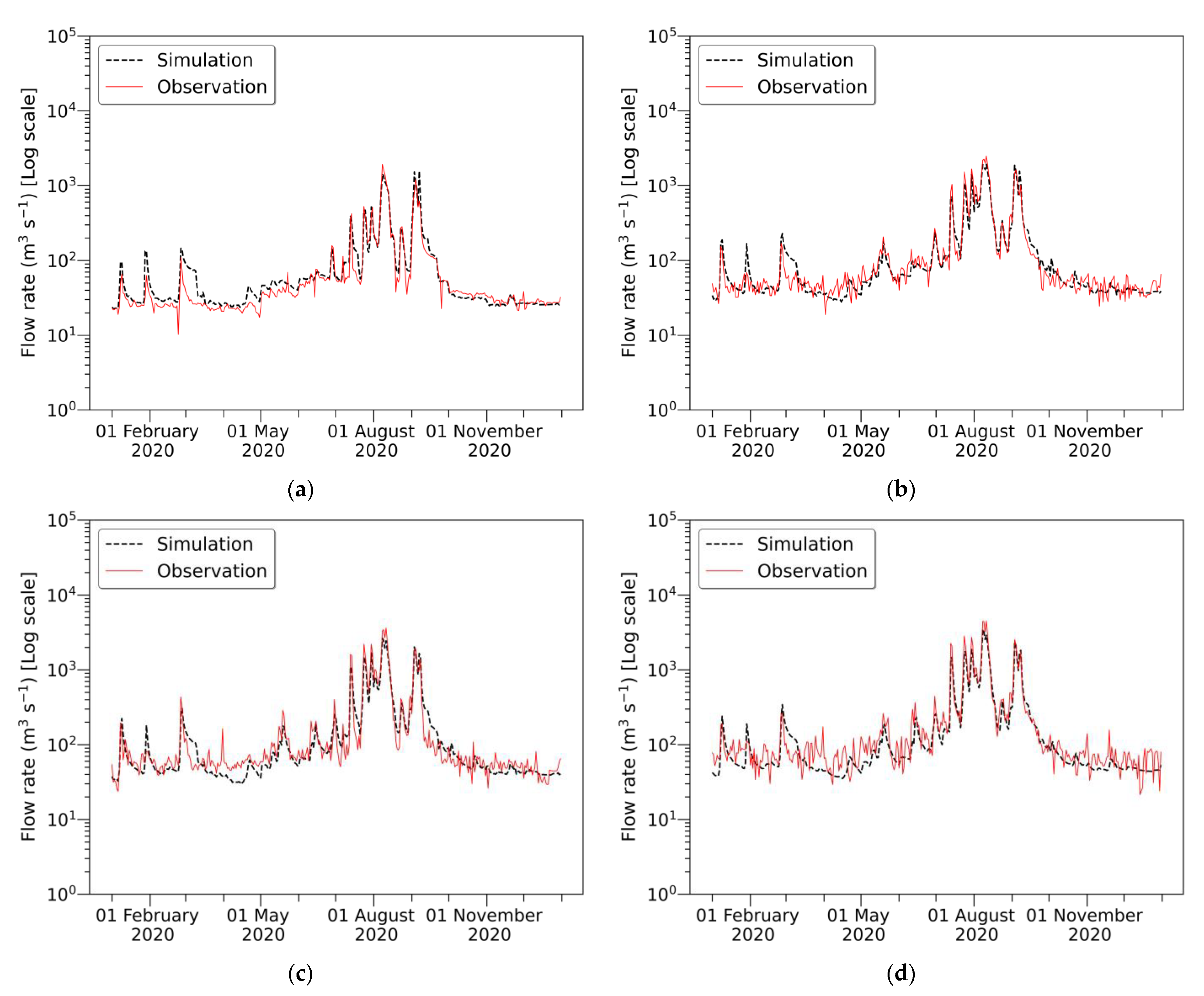

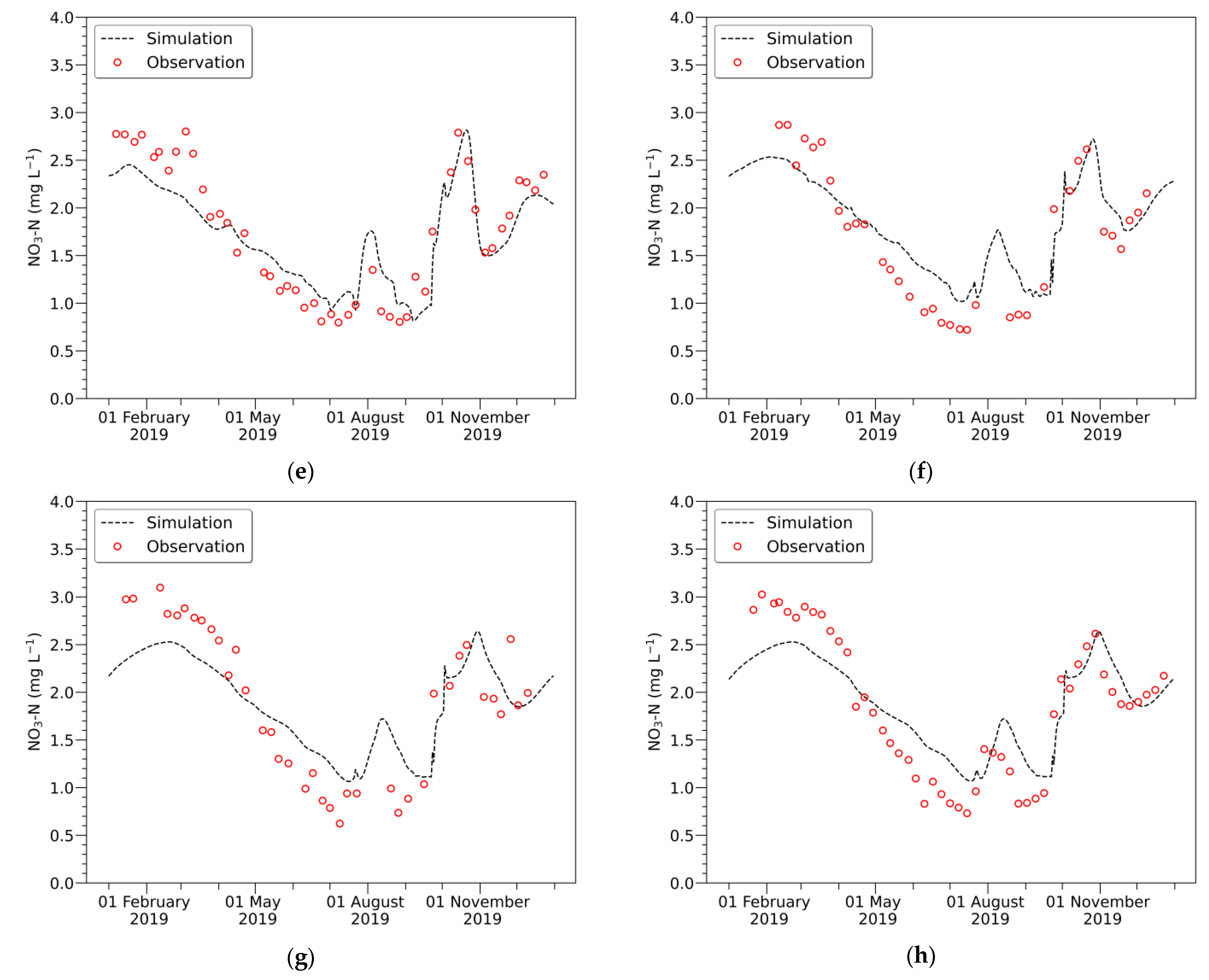

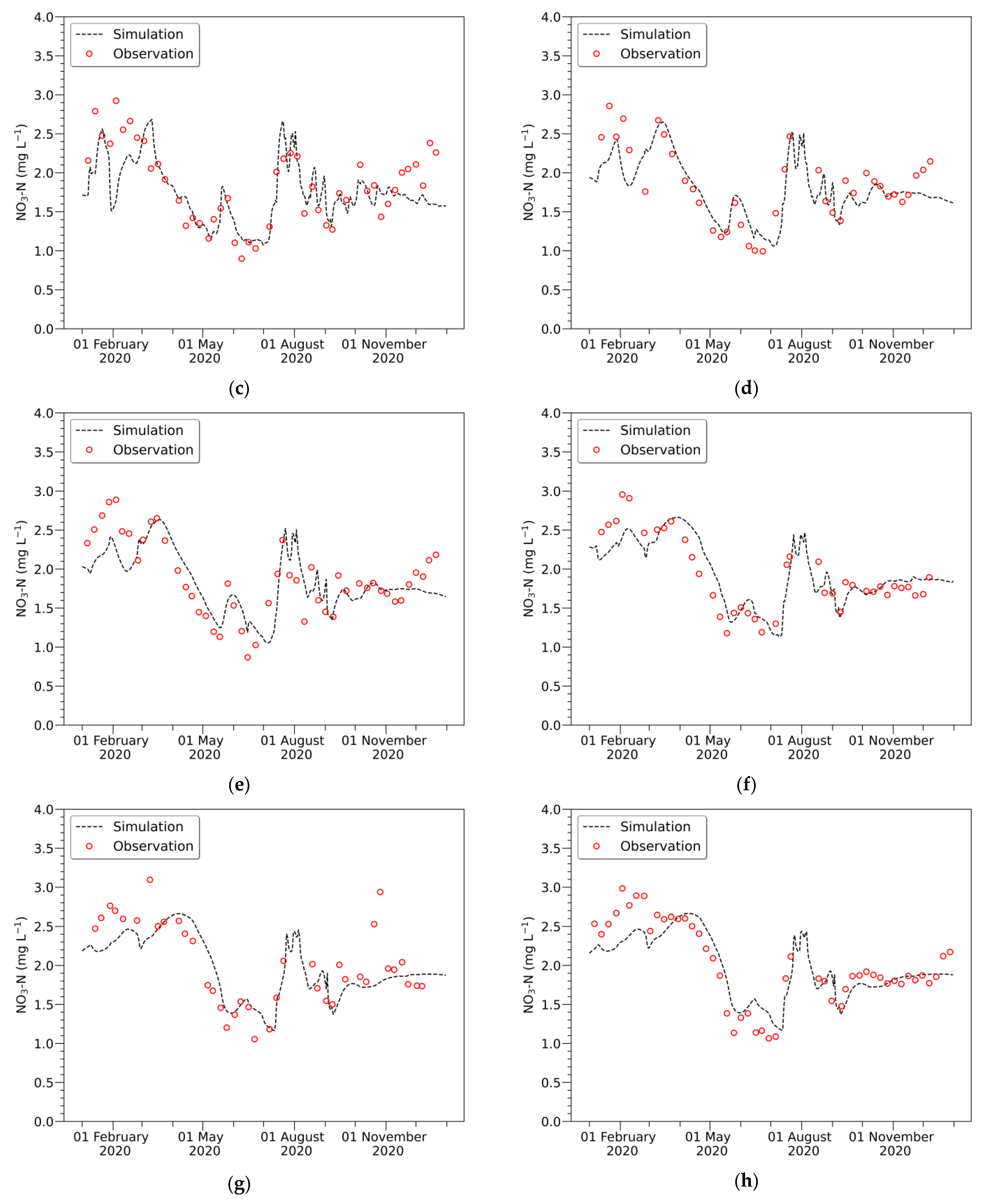
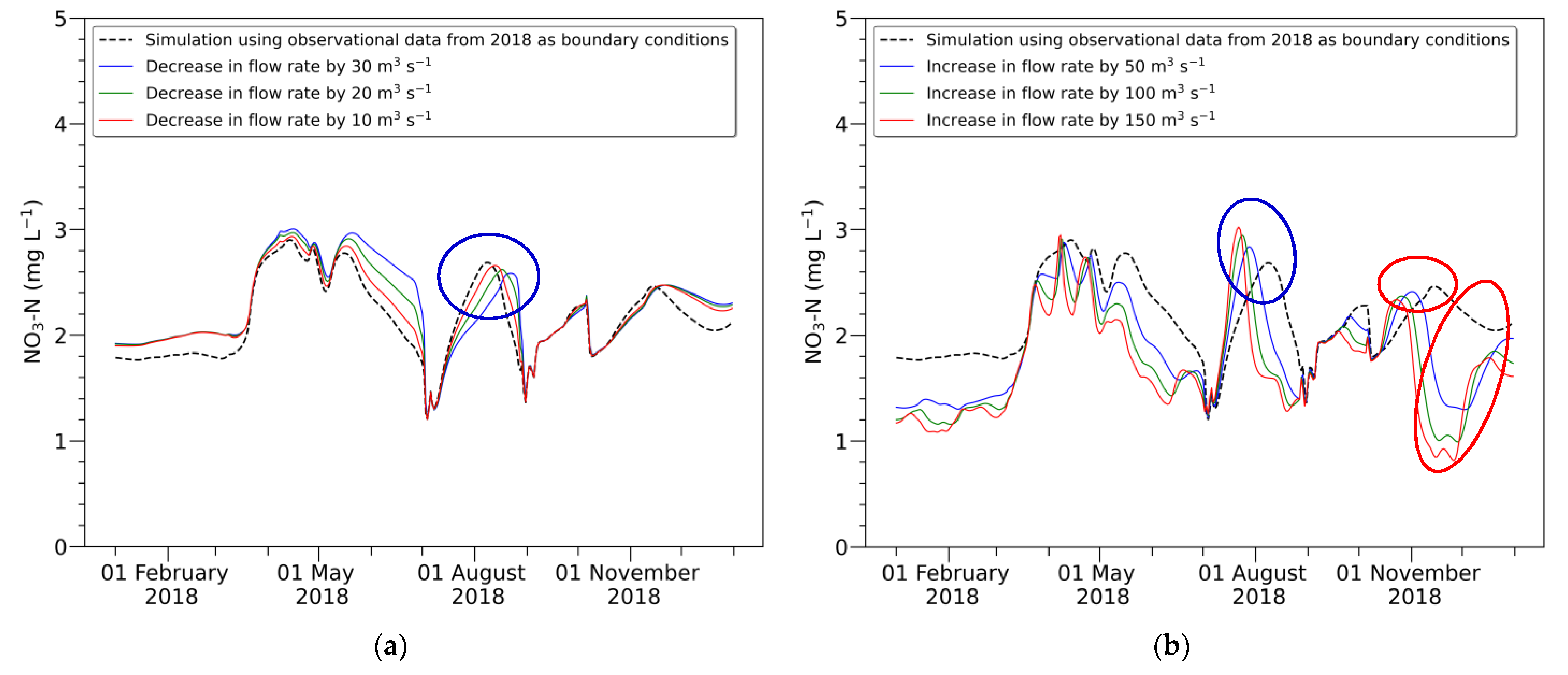
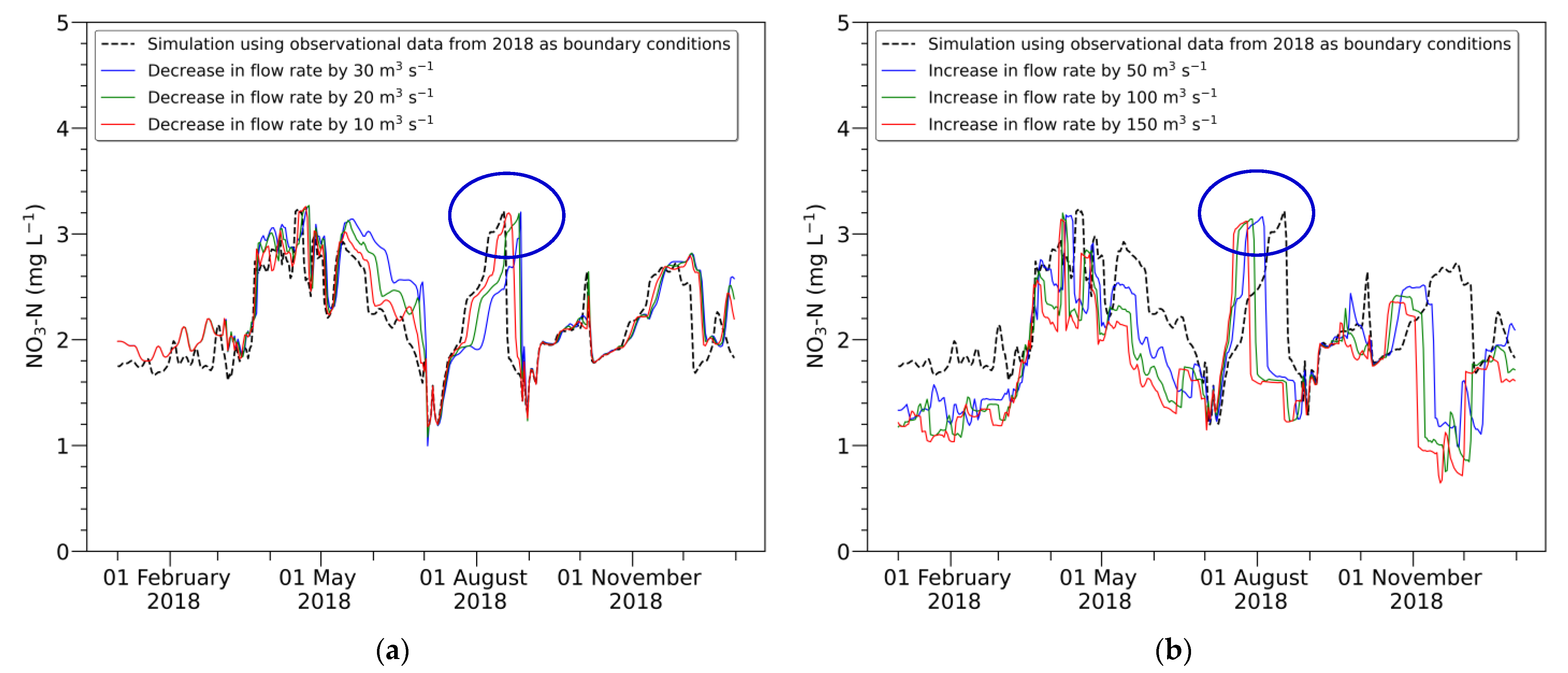
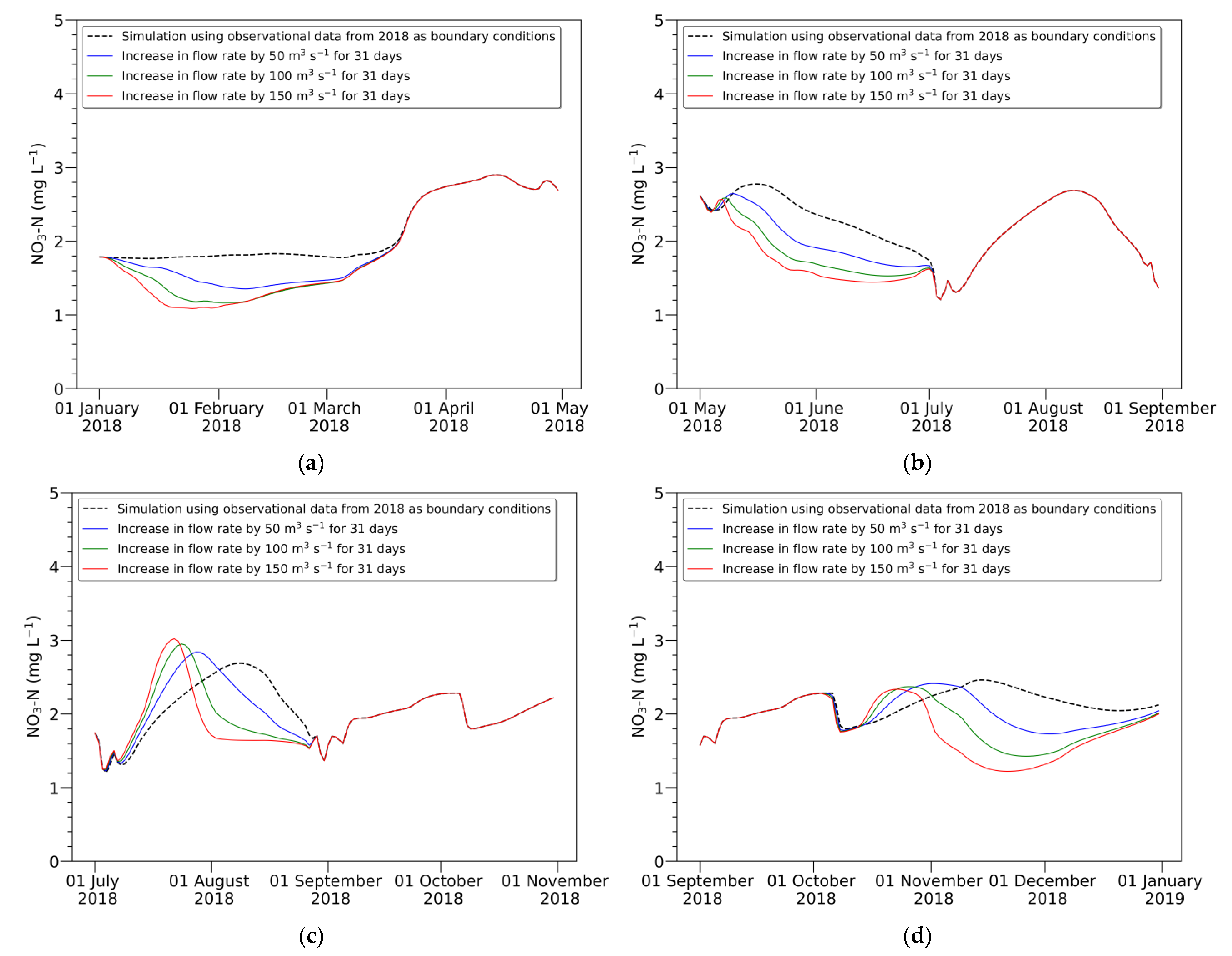

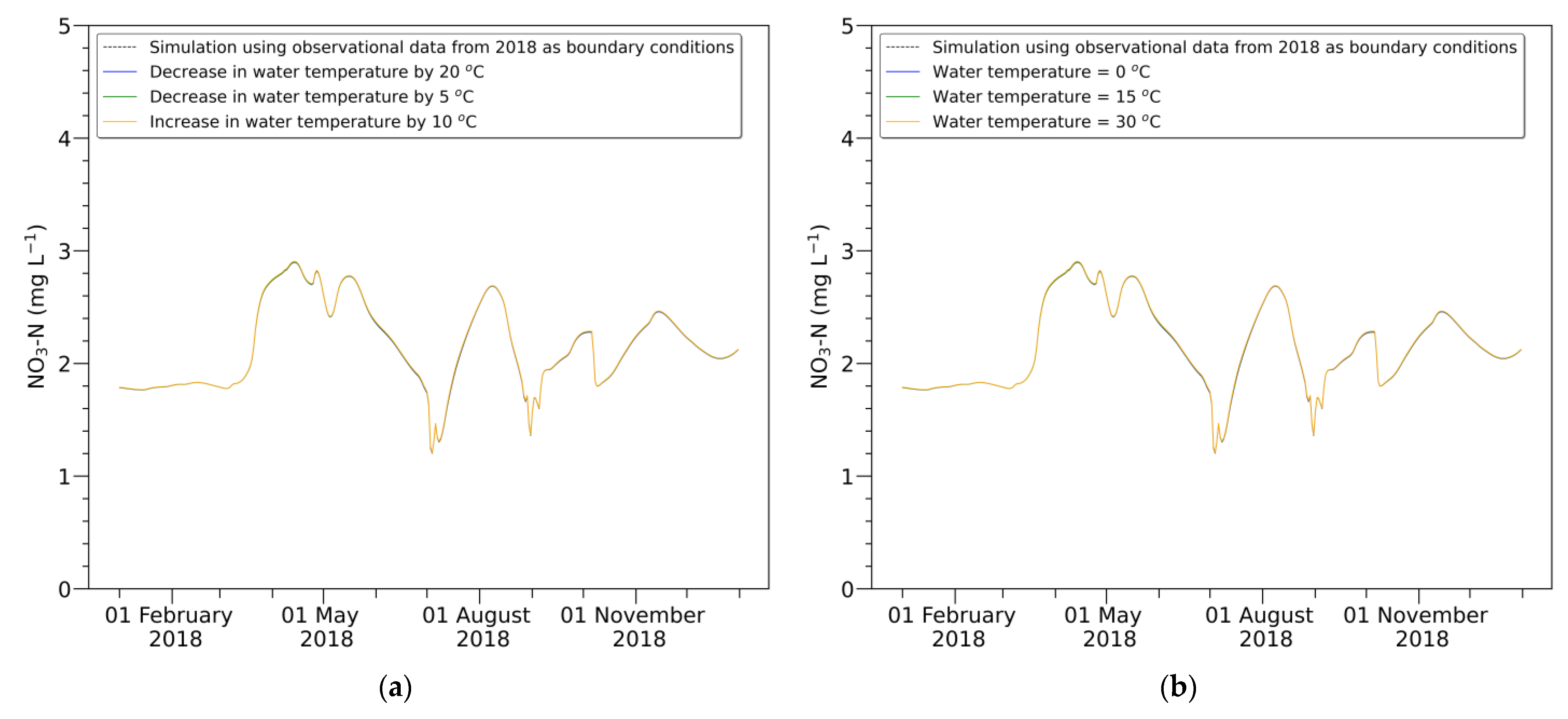
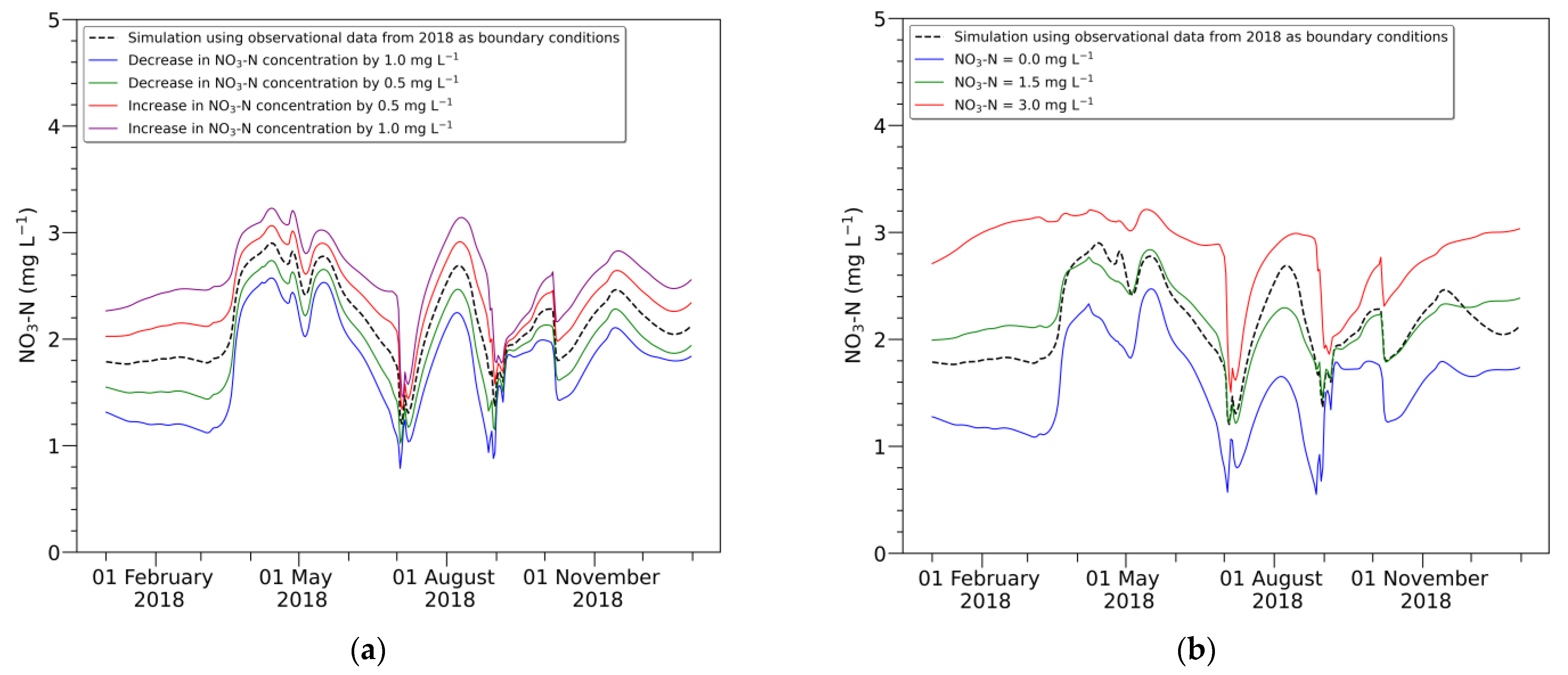

| Reservoir | Andong | Imha |
|---|---|---|
| Area of catchment (km2) | 1584.0 | 1361.0 |
| Height of dam (m) | 83.0 | 73.0 |
| Length of dam (m) | 612.0 | 515.0 |
| Normal high water level (mamsl) | 160.0 | 163.0 |
| Effective storage volume (106 m3) | 1000.0 | 424.0 |
| Weir | Sangju | Nakdan | Gumi | Chilgok |
|---|---|---|---|---|
| Area of catchment (km2) | 7407.0 | 9221.0 | 9557.0 | 11,040.0 |
| Height (m) | 11.0 | 11.5 | 11.0 | 11.8 |
| Length (m) | 335.0 | 286.0 | 374.3 | 400.0 |
| Water level for management (mamsl) | 47.0 | 40.0 | 32.5 | 25.5 |
| Storage volume (106 m3) | 27.4 | 34.7 | 52.7 | 75.3 |
| Data (Unit) | Cross Section Number | Calibration (2019) | Validation (2020) | ||||
|---|---|---|---|---|---|---|---|
| Mean | Minimum | Maximum | Mean | Minimum | Maximum | ||
| Flow rate (m3 s−1) | 620 | 48.85 | 5.06 | 976.45 | 94.41 | 10.38 | 1909.73 |
| 559 | 76.78 | 17.30 | 1675.61 | 173.68 | 18.84 | 2499.44 | |
| 505 | 98.87 | 4.27 | 3031.83 | 212.05 | 23.78 | 3632.07 | |
| 437 | 116.09 | 24.06 | 4677.58 | 270.62 | 21.50 | 4495.12 | |
| NO3-N (mg L−1) | 658 | 1.313 | 0.679 | 3.038 | 1.445 | 1.055 | 2.453 |
| 620 | 1.398 | 0.240 | 3.058 | 1.547 | 1.095 | 2.512 | |
| 559 | 1.750 | 0.807 | 2.872 | 1.844 | 0.900 | 2.924 | |
| 517 | 1.688 | 0.651 | 2.935 | 1.840 | 0.993 | 2.858 | |
| 503 | 1.760 | 0.798 | 2.803 | 1.884 | 0.869 | 2.890 | |
| 459 | 1.693 | 0.722 | 2.871 | 1.917 | 1.179 | 2.957 | |
| 427 | 1.886 | 0.624 | 3.099 | 2.011 | 1.055 | 3.095 | |
| 416 | 1.841 | 0.732 | 3.027 | 2.009 | 1.066 | 2.986 | |
| Parameter | Description | Default Value |
|---|---|---|
| Beta 3 | Rate constant: DON→NH4-N | 0.020 |
| Beta 1 | Rate constant: NH4-N→NO2-N | 0.100 |
| Beta 2 | Rate constant: NO2-N→NO3-N | 0.200 |
| Sigma 4 | Settling rate (DON) | 0.001 |
| KNR | Nitrification inhibition coefficient | 0.600 |
| Components * | Increment/Decrement | Period | Start Date | Scenario | |
|---|---|---|---|---|---|
| Water quantity | Flow rate (m3 s−1) | −30 | 365 days | 1 January | Scenario 1 |
| −20 | Scenario 2 | ||||
| −10 | Scenario 3 | ||||
| +50 | Scenario 4 | ||||
| +100 | Scenario 5 | ||||
| +150 | Scenario 6 | ||||
| +50 +100 +150 | 10 days 20 days 31 days | 1 January 1 May 1 July 1 October | Scenario 7–42 | ||
| Water quality | Water temperature (°C) | –20 | 365 days | 1 January | Scenario 43 |
| −5 | Scenario 44 | ||||
| +10 | Scenario 45 | ||||
| Constant 0 | Scenario 46 | ||||
| Constant 15 | Scenario 47 | ||||
| Constant 30 | Scenario 48 | ||||
| NO3-N (mg L−1) | −1.0 | 365 days | 1 January | Scenario 49 | |
| −0.5 | Scenario 50 | ||||
| +0.5 | Scenario 51 | ||||
| +1.0 | Scenario 52 | ||||
| Constant 0.0 | Scenario 53 | ||||
| Constant 1.5 | Scenario 54 | ||||
| Constant 3.0 | Scenario 55 | ||||
| Cross Section Number | Manning Roughness Coefficient |
|---|---|
| 411–467 | 0.024 |
| 468–672 | 0.026 |
| 673–689 | 0.028 |
| Calibration/Validation | Cross Section Number | R2 | NSE | PBIAS (%) | Performance |
|---|---|---|---|---|---|
| Calibration | 620 | 0.956 | 0.612 | −10.3 | Satisfactory |
| 559 | 0.975 | 0.945 | 2.0 | Very Good | |
| 505 | 0.967 | 0.962 | 10.5 | Satisfactory | |
| 437 | 0.929 | 0.866 | 11.7 | Satisfactory | |
| Validation | 620 | 0.875 | 0.870 | −9.4 | Good |
| 559 | 0.948 | 0.937 | 6.5 | Good | |
| 505 | 0.952 | 0.918 | 9.8 | Good | |
| 437 | 0.963 | 0.917 | 16.7 | Not Satisfactory |
| Water Quality Parameter (Unit) | Cross Section Number | ||||||||
|---|---|---|---|---|---|---|---|---|---|
| 658 | 620 | 559 | 517 | 503 | 459 | 427 | 416 | ||
| Water temperature (°C) | Observation | 15.0 | 14.5 | 16.4 | 16.7 | 15.7 | 16.2 | 17.4 | 15.7 |
| Simulation | 13.8 | 12.8 | 12.5 | 12.6 | 12.0 | 12.8 | 12.4 | 12.1 | |
| DO (mg L−1) | Observation | 10.6 | 10.5 | 10.6 | 11.0 | 10.9 | 10.4 | 10.8 | 10.3 |
| Simulation | 10.6 | 10.6 | 10.8 | 10.8 | 11.0 | 10.8 | 10.9 | 11.1 | |
| DON (mg L−1) | Observation | 0.483 | 0.424 | 0.418 | 0.428 | 0.359 | 0.375 | 0.425 | 0.379 |
| Simulation | 0.410 | 0.411 | 0.397 | 0.410 | 0.402 | 0.420 | 0.418 | 0.416 | |
| NH4-N (mg L−1) | Observation | 0.062 | 0.048 | 0.055 | 0.045 | 0.053 | 0.050 | 0.077 | 0.091 |
| Simulation | 0.045 | 0.043 | 0.044 | 0.037 | 0.033 | 0.041 | 0.033 | 0.032 | |
| NO3-N (mg L−1) | Observation | 1.379 | 1.473 | 1.798 | 1.765 | 1.822 | 1.810 | 1.949 | 1.925 |
| Simulation | 1.310 | 1.324 | 1.664 | 1.709 | 1.772 | 1.847 | 1.899 | 1.917 | |
| Calibration/Validation | Cross Section Number | R2 | NSE | PBIAS (%) | Performance |
|---|---|---|---|---|---|
| Calibration | 658 | 0.789 | 0.750 | 5.7 | Very Good |
| 620 | 0.438 | 0.301 | 10.3 | Not Satisfactory | |
| 559 | 0.766 | 0.667 | 9.5 | Very Good | |
| 517 | 0.849 | 0.801 | 3.5 | Very Good | |
| 503 | 0.872 | 0.828 | 3.7 | Very Good | |
| 459 | 0.895 | 0.803 | −5.0 | Very Good | |
| 427 | 0.816 | 0.732 | 0.5 | Very Good | |
| 416 | 0.852 | 0.777 | −1.7 | Very Good | |
| Validation | 658 | 0.621 | 0.478 | 4.4 | Satisfactory |
| 620 | 0.366 | −0.155 | 10.0 | Not Satisfactory | |
| 559 | 0.494 | 0.442 | 5.7 | Satisfactory | |
| 517 | 0.652 | 0.640 | 2.8 | Good | |
| 503 | 0.611 | 0.605 | 1.8 | Good | |
| 459 | 0.750 | 0.749 | 0.4 | Very Good | |
| 427 | 0.606 | 0.575 | 4.5 | Good | |
| 416 | 0.791 | 0.764 | 2.4 | Very Good |
| Flow Rate | NO3-N | ||||
|---|---|---|---|---|---|
| Increment (m3 s−1) | Rate of Increment (%) | Concentration (mg L−1) | Date | Reduction in Concentration (mg L−1) | Rate of Reduction (%) |
| 0 | - | 2.463 | 14 November | - | - |
| 50 | 33.3 | 2.414 | 1 November | 0.049 | 2.0 |
| 100 | 66.7 | 2.371 | 26 October | 0.091 | 3.7 |
| 150 | 100.0 | 2.337 | 23 October | 0.126 | 5.1 |
| 0 | - | 2.046 | 21 December | - | - |
| 50 | 33.3 | 1.299 | 2 December | 0.747 | 36.5 |
| 100 | 66.7 | 0.992 | 28 November | 1.054 | 51.5 |
| 150 | 100.0 | 0.813 | 26 November | 1.233 | 60.3 |
Disclaimer/Publisher’s Note: The statements, opinions and data contained in all publications are solely those of the individual author(s) and contributor(s) and not of MDPI and/or the editor(s). MDPI and/or the editor(s) disclaim responsibility for any injury to people or property resulting from any ideas, methods, instructions or products referred to in the content. |
© 2023 by the authors. Licensee MDPI, Basel, Switzerland. This article is an open access article distributed under the terms and conditions of the Creative Commons Attribution (CC BY) license (https://creativecommons.org/licenses/by/4.0/).
Share and Cite
Kim, J.; Jonoski, A.; Solomatine, D.P.; Goethals, P.L.M. Water Quality Modelling for Nitrate Nitrogen Control Using HEC-RAS: Case Study of Nakdong River in South Korea. Water 2023, 15, 247. https://doi.org/10.3390/w15020247
Kim J, Jonoski A, Solomatine DP, Goethals PLM. Water Quality Modelling for Nitrate Nitrogen Control Using HEC-RAS: Case Study of Nakdong River in South Korea. Water. 2023; 15(2):247. https://doi.org/10.3390/w15020247
Chicago/Turabian StyleKim, Jongchan, Andreja Jonoski, Dimitri P. Solomatine, and Peter L. M. Goethals. 2023. "Water Quality Modelling for Nitrate Nitrogen Control Using HEC-RAS: Case Study of Nakdong River in South Korea" Water 15, no. 2: 247. https://doi.org/10.3390/w15020247
APA StyleKim, J., Jonoski, A., Solomatine, D. P., & Goethals, P. L. M. (2023). Water Quality Modelling for Nitrate Nitrogen Control Using HEC-RAS: Case Study of Nakdong River in South Korea. Water, 15(2), 247. https://doi.org/10.3390/w15020247









